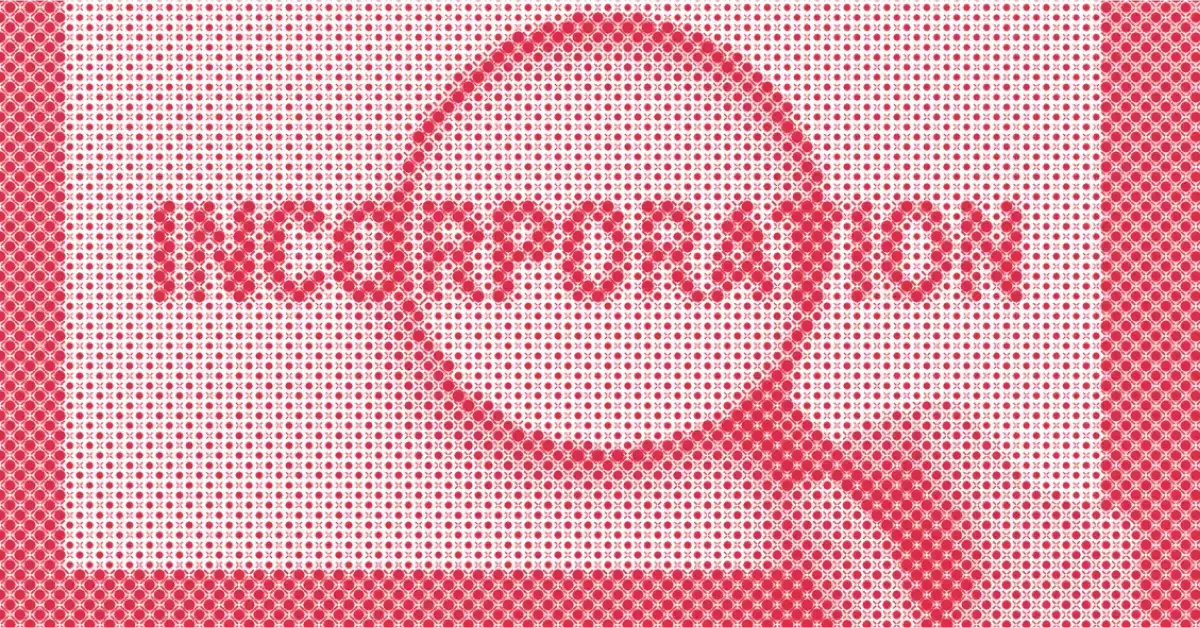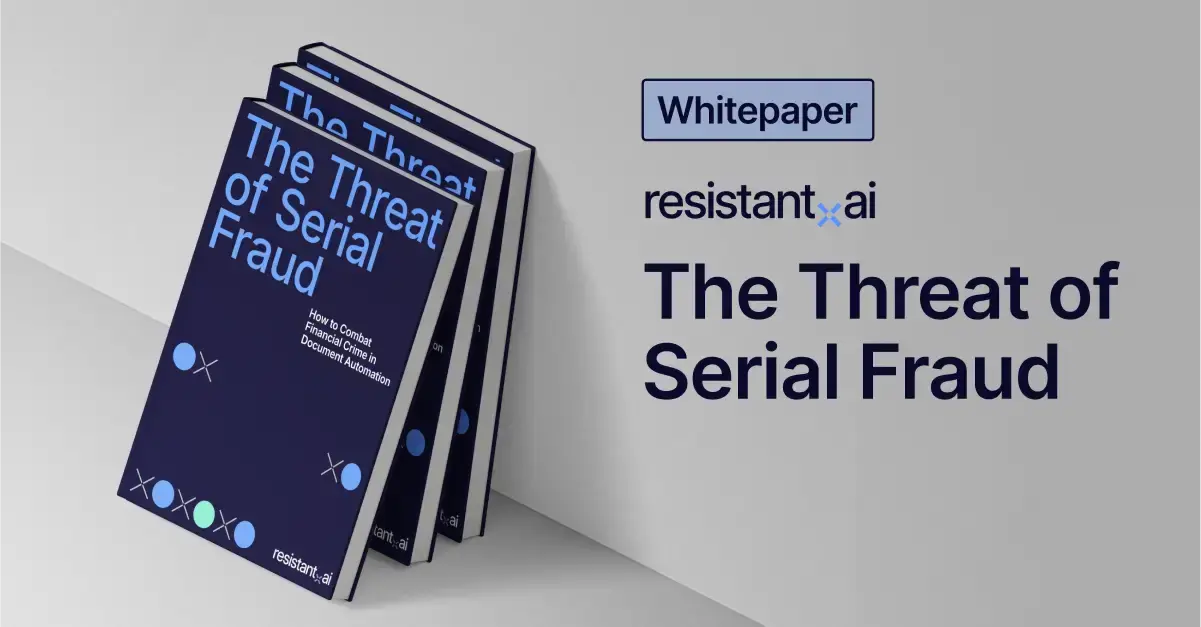
You might be interested in










Fake certificates of incorporation are on the rise in 2025 due to the growing sophistication of digital forgery tools and the global accessibility of generative AI.
Many fraudulent actors now rely on publicly available document databases and design tools to recreate near-perfect replicas of legitimate incorporation certificates.
Certificates of incorporation are often required to verify the legitimacy of a business, apply for banking services, and engage in financial transactions. Detecting document fraud can mean the difference between a valuable partnership and onboarding a liability.
Read on to learn what a certificate of incorporation is, how they’re being forged, how to identify a fake certificate of incorporation, and how AI-powered verification solutions can help spot them automatically.
Check out our "How to spot fake documents" blog to learn about more common document forgeries.
A certificate of incorporation is issued by a government agency to confirm the formation of a legal business entity (such as a corporation or limited company).
A certificate of incorporation typically includes the following components:
Company name and registration number
Date of incorporation
Jurisdiction (state, country) of registration
Names and addresses of directors and officers
Company type (LLC, Inc., Ltd, etc.)
Registered address
Authorized capital (if applicable)
These contents help assess the legal existence, registration validity, and corporate identity of a business entity.

An example of a certificate of incorporation for illustrative purposes only
Commonly used in the Know Your Business (KYB) process, the certificate of incorporation serves as a primary source of verification for a company’s legal existence, registration details, and corporate identity.
It’s also used for opening business bank accounts, entering into contracts, applying for licenses, and verifying legitimacy.
Here’s how certificates of incorporation are used for document verification across specific industries:
Banking and finance. To verify that a business is legally registered before opening accounts or offering loans.
Real estate. For leasing or purchasing property under a corporate entity.
Procurement and supply chain. To confirm the authenticity of vendors.
Regulatory compliance. During KYC (Know Your Customer) and AML (Anti-Money Laundering) processes.
International business. For cross-border registration and licensing.
It’s commonly used for these processes because it represents an official, government-backed record of existence — making it one of the most trusted verification methods in legal and financial processes for corporations/institutions.
If you’d like to know how fraudsters are creating all these fake certificates of incorporation, check out our “Types of fraud” blog to learn more about their tactics.
Our Threat Intelligence Unit collects data about template farms which make and distribute fake document templates for fraudulent purposes.
Below, you'll find an infographic containing data about all the fake certificate of incorporation templates we've found: their availability, their distributors, and how much it costs to buy one.

Find more information about the threat these farms pose in our threat intel blog and webinar content.
If you’re trying to spot fake certificates of incorporation manually then you have to be aware of the universal red flags that indicate risk or certificate of incorporation fraud. Here’s a comprehensive list of common signs of document fraud along with specific examples from certificates of incorporation:
Certificates of incorporation follow standardized templates issued by government authorities. Forgeries often include formatting issues such as:
Font inconsistencies. Different fonts or font sizes used for entity names, dates, or registration numbers.
Misaligned text and spacing. The company’s name, certificate number, or another element is not aligned with standard margins.
Incorrect page layout. Absence of government letterhead, missing border elements, or page dimensions that differ from official standards.
Low-resolution graphics. Pixelated government seals, blurry emblems, or scanned logos that don't match the issuing agency's quality.
Improper capitalization. Company name or government authority written in lowercase or inconsistent capitalization throughout the document.
Watermark discrepancies. Watermarks that appear generic, faint, or do not match the issuing agency’s known watermark.
Unprofessional file formats. Instead of a digitally signed PDF from a registry, the document is submitted as a JPEG, Word file, PSD, or something else.
Certificate of incorporation scams may contain data that doesn't align with official records:
Fake or unregistered company name. The entity listed cannot be found in the government’s business registry.
Wrong jurisdiction. For example, a U.S. company with a registration from an unrelated foreign agency (e.g., "Companies House UK").
Mismatched incorporation date. The document claims the company was formed years before it existed online.
Fabricated registration numbers. Random numbers used that don't follow the format used by the issuing body.
Inaccurate addresses. Registered office locations listed as residential buildings or virtual office services.
Inconsistent officer information. Names of directors/officers don’t match known LinkedIn profiles or business databases.
Fake certificates may include capital or shareholder data that simply doesn’t make sense:
Excessive authorized capital. For example, a one-person startup claiming an authorized share capital of $500 million.
Fractional ownership percentages. Ownership stakes broken down into decimals that are not standard in incorporation filings.
Out-of-place currencies. Capital listed in a currency not used by the registration jurisdiction (e.g., Euros on a U.S. certificate).
Illogical business type. A “non-profit” organization listed as a “corporation for profit” or vice versa.
Contradictory statements or terminology misuse are strong indicators of certificate of incorporation fraud:
Mix of business types. Document states “Limited Liability Company” in one section and “Public Limited Company” in another.
Conflicting dates. Different incorporation dates listed on the header and footer.
Wrong terminology. Use of generic business terms instead of the specific legal language (e.g., “owner” instead of “shareholder”).
Signature mismatches. Signatures or stamps from agencies that don’t align with the listed jurisdiction.
Even well-formatted documents can fail behind the scenes. Metadata can reveals the document’s true origin:
Edited with unauthorized software. Metadata reveals edits made using Photoshop or Word instead of registry-issued software.
Missing digital signature. No trace of official electronic signing or timestamp from a government registrar.
Unusual creation timestamps. The creation date shouldn’t precede the incorporation date, but the incorporation date can typically precede the creation date. For example, someone could request a new version of the document several years after the company has been incorporated.
Incorrect author field. Author field lists an individual or unrelated company instead of the issuing authority.
Disclaimer: Verifying all of these elements manually is time-intensive and error-prone. Fraudsters are constantly refining their methods, which makes AI-powered document fraud detection not just helpful—but necessary.
If you want to successfully spot fake certificates of incorporation, there are two main methods: manual verification and using AI software.
We recommend using a layered AI certificate of incorporation checker to expedite the process and adequately defend the advanced tactics of fraudsters (like serial or industrialized fraud attacks).
Manual inspections present reliability concerns as they are limited by the naked eye, often failing to detect minute or unseen changes.
Still, stopping certificate of incorporation fraud is a complex process and manual verification has its place. Cross referencing the document across trustworthy sources and internal documentation is a great place to start.
However, eventually, you’ll have to move on to an AI solution if you want to tackle the issue at scale.
Compliance officers, procurement managers, and regulators/investigators can reduce certificate of incorporation fraud via extensive research and the cross-referencing of internal information and external databases. Here’s how:
Cross-check with official business registries (e.g., Companies House UK, Secretary of State databases in the U.S., ASIC in Australia, and Orbis or OpenCorporates for multi-jurisdiction checks).
Validate registration numbers against online government databases.
Check company ownership and structure. Use tools like Dun & Branstreets (D-U-N-S numbers), LexisNexis, and Moody’s Orbis to research ownership hierarchies, ownership deals, and ultimate beneficial owner (UBO) to spot shell companies or circular ownership.
Contact registration agent or local chambers. Reach out to registered agents listed on the document or the local chamber of commerce.
Linkedin and business directories. Does the company headcount match their claimed size? Does leadership align with what’s listed on the certificate? You can also use sites like: Crunchbase, Zoominfo, and Apollo.io.
Request notarized copies. From the company or issuing authority
Keep in mind: This is slow, inconsistent, and depends on the availability of public data. In many regions, online business registry data is limited or outdated.
Even skilled reviewers miss fakes. AI and automation are now essential.
Using an AI-powered certificate of incorporation checker (like ours at Resistant AI) can greatly help financial institutions, fintechs, regulatory and compliance teams, and B2B marketplace platforms mitigate risks and scale fraud prevention and detection efforts.
Automate your certificate of incorporation processing with integrated document fraud detection software tools to achieve:
Instant verification at scale. Automatically validates registration numbers, entity names, and jurisdictions across global registries — eliminating manual cross-checking and speeding up KYB workflows.
Fraud pattern detection. Uses AI to detect subtle signs of tampering like font mismatches, inconsistent metadata, or reused document templates common in synthetic document fraud.
Seamless workflow integration. Easily plugs into onboarding or compliance systems (e.g., CRMs, KYB platforms) to enable real-time decisioning without disrupting operations.
Audit-Ready Evidence Trails
Captures and logs all verification steps and risk signals for compliance audits, helping satisfy regulatory reporting and internal reviews.
These models continuously improve through retraining, allowing them to detect even the most sophisticated synthetic forgeries in real time.
By utilizing AI, procurement managers, acquisitions specialists, and regulators can save time and resources while trying to spot certificate of incorporation scams.
In document verification, basic automation relies on rigid, rules-based logic to flag discrepancies in certificates of incorporation — effective for routine tasks but easily broken by slight formatting changes or unexpected inputs.
AI, by contrast, learns patterns and context, enabling it to recognize authentic documents even when they deviate from known templates or contain unforeseen variations.
While automation works well for predictable scenarios, AI is built to adapt, making it far more resilient against evolving fraud tactics.
Fake certificates of incorporation are a growing threat in 2025, but organizations can stay ahead with proactive document verification solutions.
Whether you’re screening vendors, verifying new clients, or onboarding businesses, AI tools can help you catch forged documents before they become a liability.
Scroll down and click the "Book a Demo" button to see how our software stops fraud at the gate.
Still hungry for more fake certificate of incorporation content? Here are some of the most frequently asked questions about fake certificates of incorporation from around the web.
AI detects forgeries by analyzing document layout, metadata, and inconsistencies using advanced algorithms. It can cross-check against known templates and registries for real-time fraud detection.
These terms are often used interchangeably but can have distinct meanings depending on the jurisdiction where they’re issued, their set purpose, and the characteristics of each.
Certificate of incorporation: Confirms that a company has been legally formed.
Articles of incorporation (Charter or Corporate Charter): Foundational document filed with the state to request the formation of a corporation. In other words, an application to receive the certificate of incorporation.
Certificate of registration. A document confirming a legal entity's registration to operate in a specific jurisdiction (often used for branches and subsidiaries). It registers the business in a state or county where it was not originally incorporated.
A certificate of incorporation proves the existence of a business; a business license grants permission to operate in a specific region or industry. One confirms formation, the other allows function.
Yes. Resistant AI’s document fraud detection tools can analyze any document type from anywhere — automatically and at scale.
Yes. Forging a certificate of incorporation is considered fraud in most jurisdictions and can result in criminal penalties, including fines and imprisonment. It often violates business, banking, and document fraud laws.
Several professionals and departments across industries are responsible for verifying certificates of incorporation to prevent fraud and ensure regulatory compliance. Key roles include:
Compliance officers. They review certificates of incorporation during Know Your Business (KYB) and Anti-Money Laundering (AML) checks to confirm that companies are legally established.
Banking and financial services underwriters. Before approving business loans, opening corporate accounts, or extending credit, underwriters must validate the authenticity of a company's incorporation documents.
Procurement and vendor management teams. They verify certificates of incorporation to ensure that suppliers, contractors, and service providers are legitimate businesses, minimizing operational and reputational risks.
Mergers and acquisitions (M&A) specialists. During due diligence phases of acquisitions or partnerships, M&A teams validate incorporation documents to confirm that target companies legally exist and have a clear corporate structure.
Legal and risk management departments. Legal teams verify corporate formation documents to assess liability risks, confirm proper business entity formation, and review shareholder or director information before contractual agreements.


